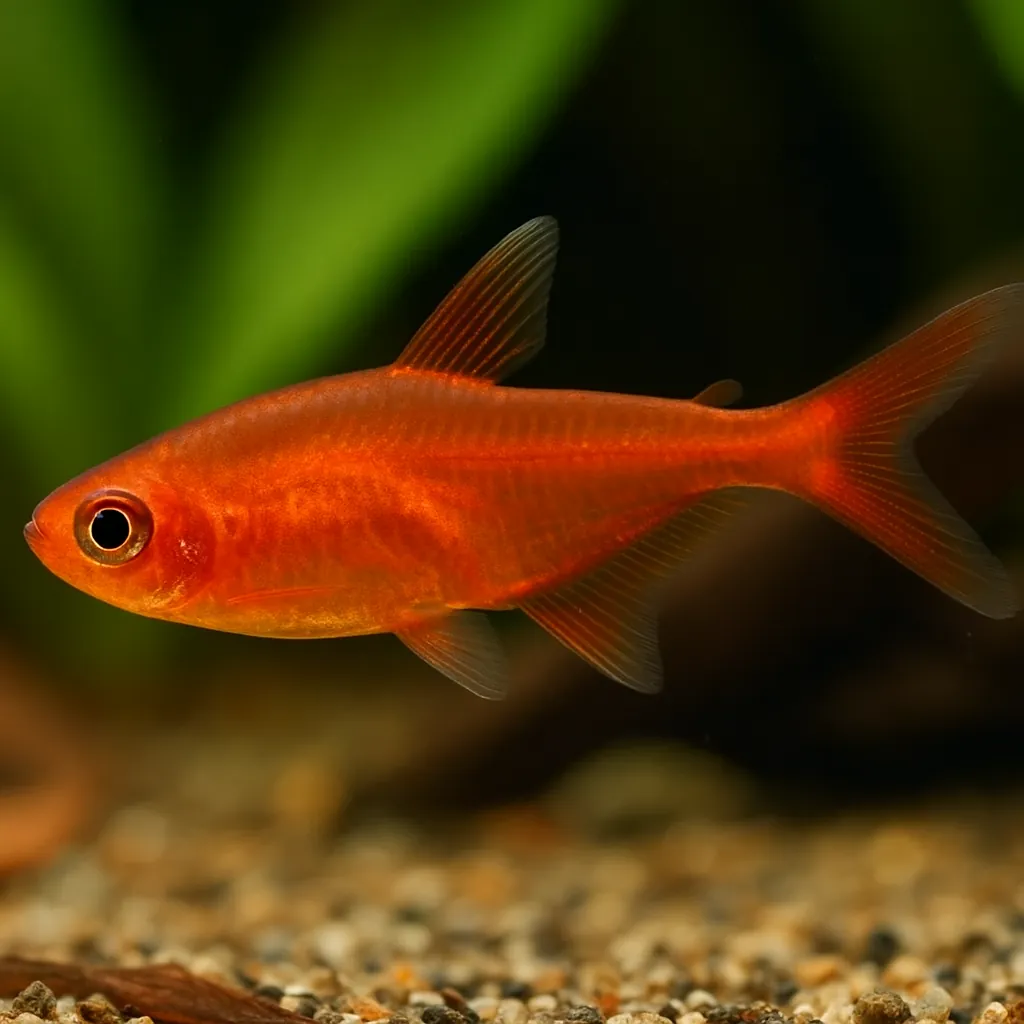
Ember tetra
Introduction
The Ember tetra (Hyphessobrycon amandae) is a small, brilliantly colored freshwater fish that has become a favorite among aquarists for its vibrant orange-red hue and peaceful nature. Its lively schooling behavior and manageable care requirements make it an appealing choice for both beginner and intermediate fishkeepers. While not as widely known as some other tetras, the Ember tetra stands out for its beauty, adaptability, and ability to bring a splash of color to nano and community tanks alike. With proper care, this species can thrive and display its best colors, making it a rewarding addition to most home aquariums.
What makes the Ember tetra a good choice for beginners?
The Ember tetra is hardy, peaceful, and adapts well to a range of aquarium conditions, making it suitable for those new to fishkeeping.
How big do Ember tetras get?
Ember tetras remain small, usually reaching an adult size of about 2 cm, which allows them to fit comfortably in smaller tanks.
Care and Environment
Caring for Ember tetras is relatively straightforward, but providing the right environment is key to their health and coloration. The minimum tank volume for a single Ember tetra is 20 litres, but a group of at least six is recommended, ideally in a 40-litre or larger aquarium. These fish thrive in stable water conditions with a temperature range of 23–28°C, a pH between 5.5 and 7.0, and soft to moderately hard water (dGH 5–17). A gentle filter that does not create strong currents is best, as Ember tetras originate from slow-moving waters.
What type of tank setup is best for Ember tetras?
A well-planted aquarium with fine-leaved plants, driftwood, and dark substrate will mimic their natural habitat and help them feel secure. Floating plants can also help diffuse lighting, which these fish prefer.
How should Ember tetras be fed?
Ember tetras are omnivorous and will accept high-quality flake, micro-pellets, and live or frozen foods like daphnia, brine shrimp, and micro-worms. Offering varied foods enhances their color and health.
Are Ember tetras sensitive to water changes?
While generally hardy, Ember tetras can be sensitive to sudden changes in water parameters. Regular, small water changes (about 20% weekly) and careful acclimatization are recommended to avoid stress.
Lighting should be moderate to low, as intense lights can cause stress and dull their coloration. The tank should be securely covered, as these small fish may jump if startled. Ember tetras are peaceful and do not display aggression, even during breeding, but their small size means they can be outcompeted for food by larger or more boisterous tankmates. Regular maintenance, stable water quality, and a calm environment will ensure these fish remain active and healthy.
Origin and Habitat
Ember tetras are native to the Araguaia River basin in central Brazil, South America. In the wild, they inhabit slow-moving tributaries, creeks, and densely vegetated areas with soft, acidic water. The natural environment features abundant aquatic plants, leaf litter, and a sandy or muddy substrate, creating a dimly lit, sheltered habitat. Seasonal flooding can expand their range into flooded forest areas, but they are most commonly found in shallow, calm waters where they can form large shoals and feed on tiny invertebrates and plant matter.
Where exactly do Ember tetras come from?
They are found in the Araguaia River basin, a region known for its rich biodiversity and clear, plant-filled waters.
What kind of water do Ember tetras prefer in the wild?
Ember tetras naturally live in soft, slightly acidic waters with plenty of plants and low light, which helps them feel safe and display their best colors.
Temperament and Compatibility
Ember tetras are peaceful, social fish that thrive when kept in groups of at least six, though larger shoals are even better for their well-being. They are active midwater swimmers and rarely show aggression towards other fish. Their shoaling nature means they feel safer and display more natural behaviors when surrounded by their own kind.
Are Ember tetras good community fish?
Yes, Ember tetras are excellent community fish when housed with other small, peaceful species such as small rasboras, dwarf corydoras, otocinclus, and other tetras.
What tank mates should be avoided with Ember tetras?
Avoid keeping Ember tetras with large, aggressive, or very active fish, as these can stress or outcompete them for food. Predatory fish or those with a tendency to nip fins are also unsuitable.
To create a harmonious tank, provide plenty of hiding spots and open swimming areas. Keeping them in a well-planted tank with gentle tank mates will bring out their best colors and behaviors.
Interesting Facts
The Ember tetra was first described in 1987 and quickly gained popularity in the aquarium trade due to its striking coloration and small size. Unlike many other tetras, Ember tetras often display their brightest colors in groups and in well-planted tanks. In the wild, they form large shoals for protection and social interaction. Breeding is possible in home aquariums, with females scattering eggs among fine-leaved plants. The fry are tiny and require infusoria or specially prepared foods to survive the first days of life.
Do Ember tetras breed easily in captivity?
While not difficult to breed, successful spawning and raising of fry require careful attention to water quality and the provision of fine plants or spawning mops.
Why are Ember tetras called "Ember" tetras?
Their name comes from their fiery orange-red coloration, which resembles a glowing ember, especially under the right lighting and in healthy, well-kept groups.
Sources
All information in this article has been gathered from the following reputable sources:
Overview
Recommended Tank Size 10.6 Gallons (for groups of 6 or more) |
Minimum Group Size 6 |
Minimum Tank Volume 5.3 Gallons |
Maximum Adult Length 0.8 inches |
Average Adult Length 0.6 inches |
Shoaling (6+ required) Yes |
Preferred Water Type Freshwater, soft, slightly acidic |
Temperature Range (°C) 23–28 |
pH Range 5.5–7.0 |
Water Hardness (dGH) 5–17 |
Typical Lifespan (years) 2 years |